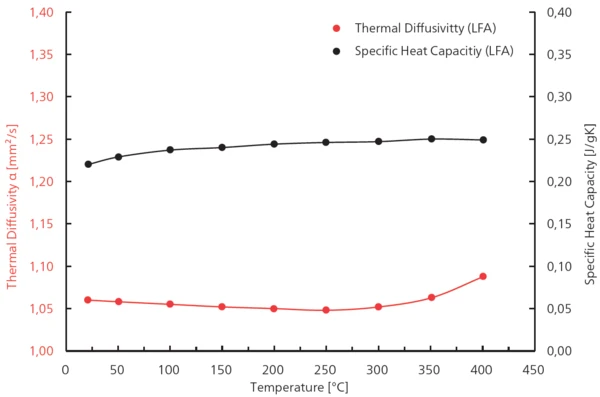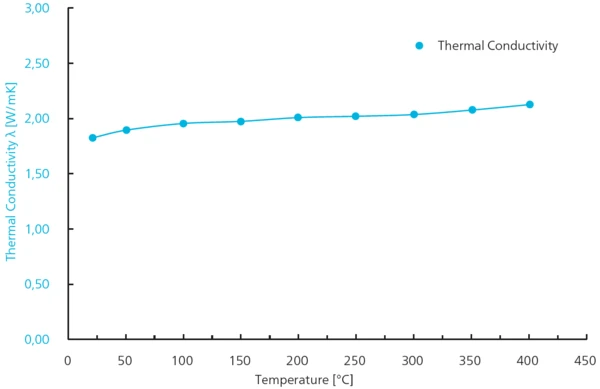The Importance of Thermoelectric Materials and Their Application Possibilities
The optimization of energy efficiency is one of the major challenges of the 21st century. In many industrial applications, huge amounts of unused thermal energy are generated. Such waste heat is produced by melting furnaces, incineration plants, power plants and even motor vehicles – and could all be used for the generation of electrical energy. Along with having a positive environmental impact, this would also contribute significantly to increasing the overall efficiency and profitability of industrial plants. That’s where thermoelectrics come into play.
“Thermoelectric generators”, as they are known, are developed and can be employed in all areas where usable temperature differences are available. Such applications require the development of thermoelectric materials with high efficiency.
Determination of Thermophysical and Thermoelectric Properties
For the development and optimization of thermoelectric materials, knowledge of the thermophysical and thermoelectric properties is essential. For assessment of the efficiency, the figure of merit (ZT value) is used. This thermoelectric figure describes how well or poorly suited a special material is for use in a thermoelectric generator. The ZT value thus yields information on the material’s efficiency.

With the Conductividad Eléctrica (SBA)Electrical conductivity is a physical property indicating a material's ability to allow the transport of an electric charge.SBA 458 Nemesis®, the Seebeck coefficient, S, and Conductividad Eléctrica (SBA)Electrical conductivity is a physical property indicating a material's ability to allow the transport of an electric charge.electrical conductivity, σ, can be determined simultaneously. Using the LFA, the Specific Heat Capacity (cp)Heat capacity is a material-specific physical quantity, determined by the amount of heat supplied to specimen, divided by the resulting temperature increase. The specific heat capacity is related to a unit mass of the specimen.specific heat capacity, cp, and Difusividad TérmicaThermal diffusivity (a with the unit mm2/s) is a material-specific property for characterizing unsteady heat conduction. This value describes how quickly a material reacts to a change in temperature.thermal diffusivity, a, can be measured directly. Along with the density, ρ, the Conductividad TérmicaThermal conductivity (λ with the unit W/(m•K)) describes the transport of energy – in the form of heat – through a body of mass as the result of a temperature gradient (see fig. 1). According to the second law of thermodynamics, heat always flows in the direction of the lower temperature.thermal conductivity, λ, can be calculated.
With the SBA 458 Nemesis® and the laser flash apparatuses LFA 427, LFA 457 and LFA 467, NETZSCH offers a complete solution for determination of the ZT value.
Skutterudite as an Appropriate Material for Thermoelectric Applications
Currently, the enormous costs for development and the presently low efficiency of thermoelectric materials often prevent their application. To overcome this, the efficiency of thermoelectrics must be significantly increased via new developments and modifications.
The objective is to develop materials exhibiting low thermal conductivity, λ, with simultaneously high conductivity, σ, and a high Seebeck coefficient, S. The difficulty here is in the fact that these three properties can only be influenced independently of one another under certain conditions.
Skutterudite in particular has the potential for excellent electrical properties. Skutterudite is a material consisting of cobalt and arsenic, often contaminated by rare earths. It belongs to the class of sulfides. It owes its name to the city of Skutterud in Norway, which is where this naturally occurring mineral, CoAs3, was first discovered in 1928. It was only in the mid-50s that its excellent electrical properties were recognized. Skutterudite features a very high charge carrier mobility and a medium-sized Seebeck coefficient. Its thermal conductivity, on the other hand, is far too high to have made its efficient use in thermoelectrical applications possible at that point in time. In the 70s, the crystal structure typical for skutterudite was discovered, which can be modified optimally. Two voids in the elementary cell can be filled by the insertion of foreign atoms. This way, the thermal conductivity of skutterudite can be reduced. Since then, skutterudites have been potential candidates for more efficient thermoelectric converters with which, for example, waste heat from the exhaust systems of automobiles could be directly converted into electricity. The following measurement examples show how the ZT value of skutterudite can be determined by means of a single sample.
LFA Measurements
For calculation of the dimensionless ZT value of skutterudite, the thermal diffusivity (figure 1, red curve) and the Specific Heat Capacity (cp)Heat capacity is a material-specific physical quantity, determined by the amount of heat supplied to specimen, divided by the resulting temperature increase. The specific heat capacity is related to a unit mass of the specimen.specific heat capacity (figure 1, black curve) were determined with the LFA 467 HyperFlash® on a sample with a diameter of 12.7 mm. The measurements were carried out between room temperature and 400°C.

Calculation of the thermal conductivity is based on the results obtained by means of the following equation: λ = a·cp·ρ (see figure 2).

SBA Measurement
With the SBA 458 Nemesis®, the Seebeck coefficient and electrical conductivity of the sample already used for the LFA measurement was determined between RT and 350°C. The Seebeck coefficient increased from 100 μV/K to almost 160 μV/K while the electrical conductivity decreased from approx. 1300 S/cm to 1000 S/cm. The measurement results exhibit excellent reproducibility (± 2%) for both parameters (see figure 3).

ZT Value
The ZT value is calculated by means of the results obtained with the LFA and SBA on the same sample (see figure 4) using the following equation:


The plot in figure 5 represents the increase in ZT value between room temperature and 400°C with a maximum at 0.75.

Summary
It was demonstrated that the thermophysical properties − inlcuding thermal diffusivity and thermal conductivity, Specific Heat Capacity (cp)Heat capacity is a material-specific physical quantity, determined by the amount of heat supplied to specimen, divided by the resulting temperature increase. The specific heat capacity is related to a unit mass of the specimen.specific heat capacity, Seebeck coefficient and electrical conductivity − can be detemined using only one sample. Thus, the user saves precious time since additional sample preparation for adjustment of the sample geometry is not necessary.